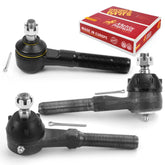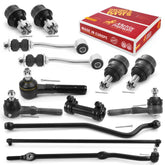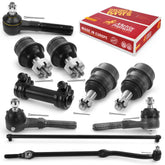Front-Wheel Drive vs. Rear-Wheel Drive: How Steering and Suspension Differ
Front-Wheel Drive vs. Rear-Wheel Drive: How Steering and Suspension Differ
When it comes to automobile engineering, two of the most prevalent drivetrain configurations are front-wheel drive (FWD) and rear-wheel drive (RWD). Both systems have their unique advantages and trade-offs, and they significantly influence the vehicle's steering and suspension characteristics. Understanding these differences is essential for any car enthusiast or potential buyer looking to make an informed decision. In this blog, we'll explore the disparities in steering and suspension between FWD and RWD vehicles.

Front-Wheel Drive (FWD)
Front-wheel drive is a configuration where the engine's power is transmitted to the front wheels, which then provide both propulsion and steering capabilities. In a typical FWD setup, the engine, transmission, and differential are combined in the front of the vehicle. This arrangement offers several advantages, including better fuel efficiency, reduced manufacturing costs, and increased interior space as the absence of a transmission tunnel allows for more cabin room.
Steering in FWD:
The primary advantage of FWD in terms of steering is the self-aligning torque, also known as the "pulling effect." When the driver turns the steering wheel, the front wheels naturally tend to return to their straight-ahead position after the turn. This is due to the driving force being applied to the same wheels that are responsible for steering, providing a stabilizing effect.
Additionally, FWD vehicles generally have a more straightforward and compact steering system. The absence of a driveshaft running from the front to the rear of the car allows for a more direct steering linkage, resulting in a responsive and agile feel during maneuvers.
Suspension in FWD:
The suspension system in an FWD car is typically simpler compared to RWD. The front wheels bear the weight of the engine and transmission, and as a result, the front suspension is often sturdier to handle this extra load. This can lead to a somewhat firmer ride, which some drivers may prefer for better handling.
However, the rear suspension in FWD cars is usually less sophisticated since it primarily deals with supporting the vehicle's weight without the added complexity of the drive components. This could potentially result in reduced traction and stability, especially under heavy acceleration or braking.

Rear-Wheel Drive (RWD)
In rear-wheel drive vehicles, the engine's power is sent to the rear wheels, and the front wheels are responsible for steering only. Historically, RWD was the more common drivetrain configuration, and it still holds a strong presence in high-performance and luxury vehicles.
Steering in RWD:
RWD cars benefit from better weight distribution compared to FWD, as the engine sits longitudinally along the vehicle's length, balancing the weight between the front and rear axles. This improved weight distribution contributes to more balanced and predictable handling, especially during high-speed cornering.
Since the front wheels are dedicated solely to steering, there is no self-aligning torque like in FWD vehicles. While this means the steering feel might be slightly less assisted, some driving enthusiasts appreciate the increased feedback and connection to the road.
Suspension in RWD:
Due to the balanced weight distribution and more even load distribution between the front and rear axles, RWD cars tend to have a more neutral and predictable suspension behavior. The rear suspension is usually more sophisticated, allowing for better traction and stability, particularly during acceleration and braking. This characteristic is particularly advantageous in sports cars, as it aids in controlling oversteer and understeer.
On the other hand, RWD cars can be more challenging to handle in adverse weather conditions, such as snow or heavy rain, as the rear wheels may have reduced traction compared to the front wheels.

The choice between front-wheel drive and rear-wheel drive depends on the driver's preferences, intended use of the vehicle, and driving conditions. Front-wheel drive offers better interior space, fuel efficiency, and a simple steering system, while rear-wheel drive provides superior weight distribution, handling balance, and suspension characteristics. Ultimately, understanding the disparities in steering and suspension between FWD and RWD vehicles empowers drivers to make an educated decision and find a car that best suits their needs and driving style.
At Metrix Premium Chassis Parts, we offer steering and suspension parts compatible with all kinds of drivetrain configurations. Whether you own a FWD, RWD or a AWD; you can find the precise match for your car.
Visit our online catalog to explore our extensive selection of parts!









